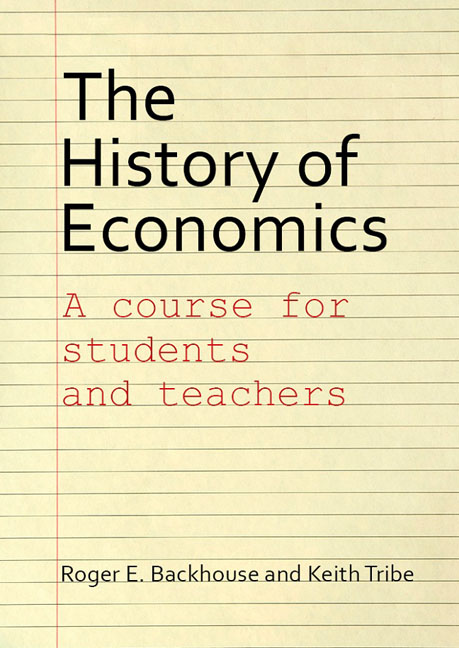Book contents
- Frontmatter
- Contents
- Introduction
- Lecture 1 Commerce, Wealth and Power: The Disputed Foundations of the Strength of a Nation
- Lecture 2 Natural Order, Physiocracy and Reform
- Lecture 3 Adam Smith I: Outline of a Project
- Lecture 4 Adam Smith II: The Two Texts
- Lecture 5 The Political Economy of Malthus and Ricardo
- Lecture 6 Political Economy in Continental Europe and the United States
- Lecture 7 Political Economy, Philosophic Radicalism and John Stuart Mill
- Lecture 8 Popular Political Economy: List, Carey, Bastiat and George
- Lecture 9 Radical Political Economy: Marx and His Sources
- Lecture 10 Marginalism and Subjectivism: Jevons and Edgeworth
- Lecture 11 From Political Economy to Economics
- Lecture 12 Alfred Marshall’s Project
- Lecture 13 Markets and Welfare after Marshall
- Lecture 14 Monetary Economics
- Lecture 15 The Rise of Mathematical Economics
- Lecture 16 Robbins’s Essay and the Definition of Economics
- Lecture 17 John Maynard Keynes
- Lecture 18 Quantitative Economics
- Lecture 19 The Keynesian Revolution
- Lecture 20 Modern Macroeconomics
- Lecture 21 Inflation and the Phillips Curve
- Lecture 22 Popular Economics
- Lecture 23 Economics and Policy
- Lecture 24 Ideology and Place
- Index
Lecture 17 - John Maynard Keynes
Published online by Cambridge University Press: 09 August 2023
- Frontmatter
- Contents
- Introduction
- Lecture 1 Commerce, Wealth and Power: The Disputed Foundations of the Strength of a Nation
- Lecture 2 Natural Order, Physiocracy and Reform
- Lecture 3 Adam Smith I: Outline of a Project
- Lecture 4 Adam Smith II: The Two Texts
- Lecture 5 The Political Economy of Malthus and Ricardo
- Lecture 6 Political Economy in Continental Europe and the United States
- Lecture 7 Political Economy, Philosophic Radicalism and John Stuart Mill
- Lecture 8 Popular Political Economy: List, Carey, Bastiat and George
- Lecture 9 Radical Political Economy: Marx and His Sources
- Lecture 10 Marginalism and Subjectivism: Jevons and Edgeworth
- Lecture 11 From Political Economy to Economics
- Lecture 12 Alfred Marshall’s Project
- Lecture 13 Markets and Welfare after Marshall
- Lecture 14 Monetary Economics
- Lecture 15 The Rise of Mathematical Economics
- Lecture 16 Robbins’s Essay and the Definition of Economics
- Lecture 17 John Maynard Keynes
- Lecture 18 Quantitative Economics
- Lecture 19 The Keynesian Revolution
- Lecture 20 Modern Macroeconomics
- Lecture 21 Inflation and the Phillips Curve
- Lecture 22 Popular Economics
- Lecture 23 Economics and Policy
- Lecture 24 Ideology and Place
- Index
Summary
Aims of the lecture
1. To uncover the “historical” John Maynard Keynes.
2. To illustrate an important approach to the history of ideas: through biography.
3. To explain how Keynes came to his major work, The General Theory of Employment, Interest and Money (1936).
4. To place Keynes’s economic theory in relation to his view of capitalism and a social philosophy that was related to his life and activities.
Recovering the historical Keynes is more difficult than it sounds because, being widely considered the most important economist of the twentieth century, his name has been used by many people – politicians and journalists as well as economists – to represent policy positions that they want to defend or attack, many of which are not informed by facts about Keynes’s life and work.
Bibliography
As is the case with Adam Smith, the enormous volume of literature on Keynes presents a problem for anyone wanting to understand the historical figure. Much of this literature on Keynes is written by people whose main interest lies in developing economic theory or defending a policy position; it deals as much with “Keynesianism”, “Keynesian economics” and “Keynesian policies” as with the ideas of Keynes himself. Such interests are perfectly legitimate but are not always consistent with developing an understanding of Keynes himself and his thinking. When reading material on Keynes it is important to think about what its author is trying to achieve.
The main source for Keynes’s works is the 30-volume Collected Writings of John Maynard Keynes (London: Macmillan, 1971–89), which contains his major economic works, including The Economic Consequences of the Peace (1919, volume II), A Tract on Monetary Reform (1923, volume IV), A Treatise on Money (1930, volumes V and VI) and The General Theory (1936, volume VII) as well as articles and correspondence, usefully grouped according to themes. The Index (volume XXX) is very useful in locating material in the voluminous writings. Of course much of this material is available elsewhere, in other editions and on the Internet.
- Type
- Chapter
- Information
- The History of EconomicsA Course for Students and Teachers, pp. 261 - 274Publisher: Agenda PublishingPrint publication year: 2017



